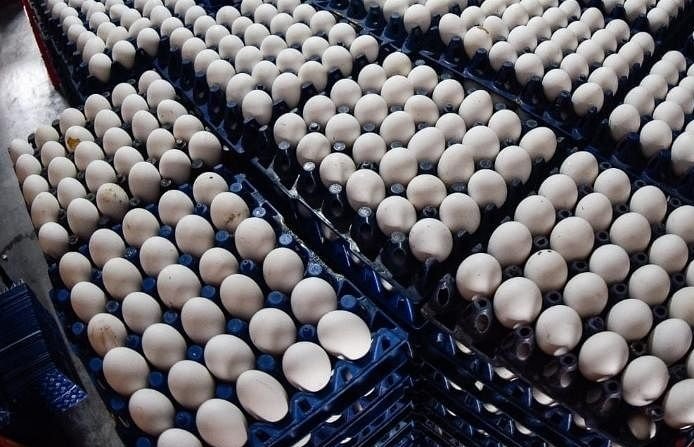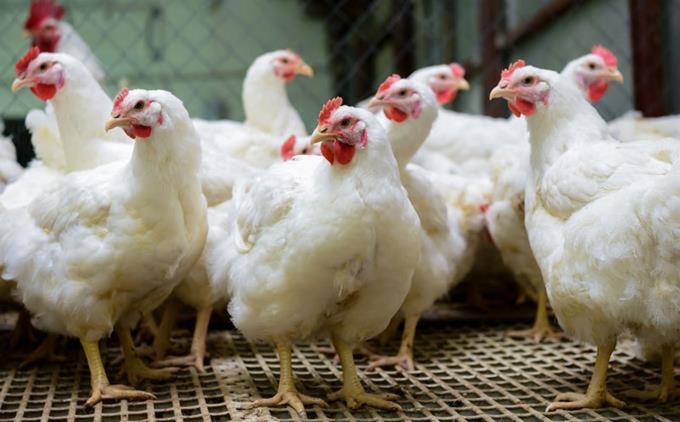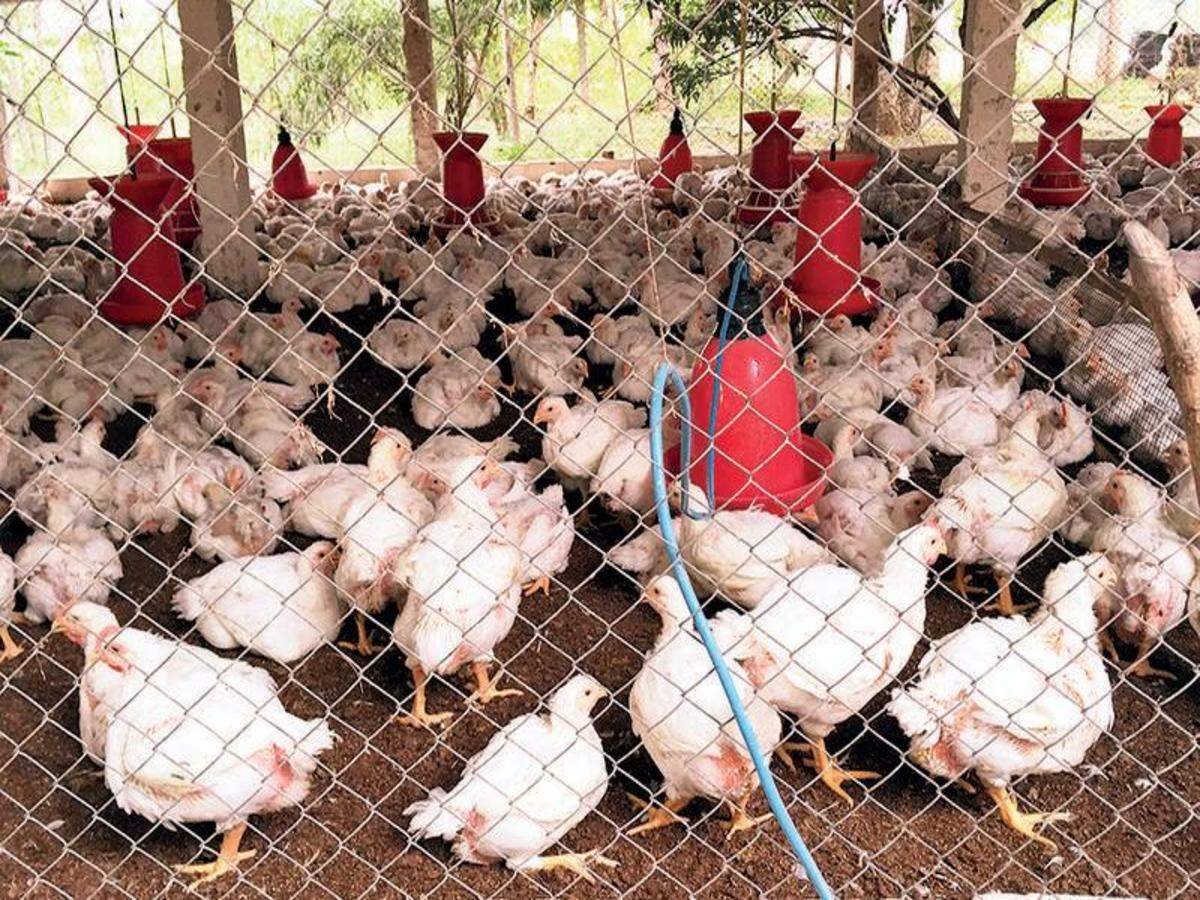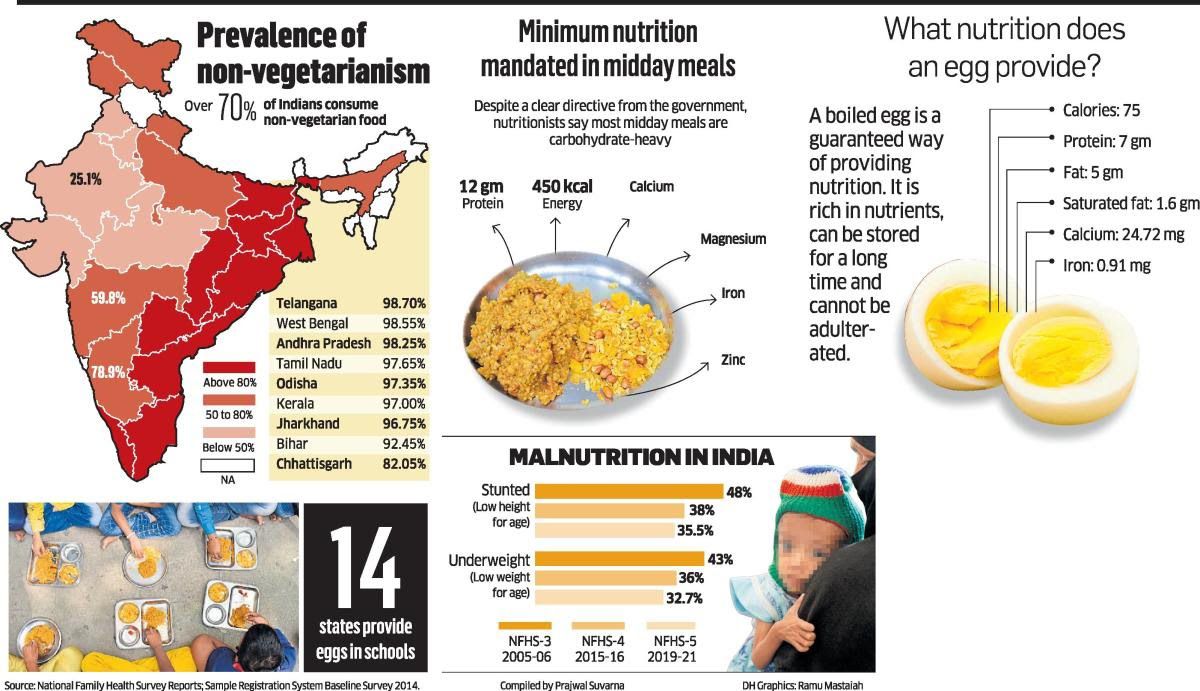Egg Quality

EGGY facts
- A hen requires between 24 and 26 hours to produce an egg.
- Thirty minutes after laying an egg she starts all over again.
- Most female animals have two functioning ovaries, but hens only use one, their left. The right ovary stays dormant.
- A female hen is born with thousands of tiny ova which will one day become egg yolks.
- A double-yolker egg is the result of two yolks being released at the same time.
- During formation, the egg moves through the oviduct small end first.
- Just before laying, it is rotated and laid large end first
- Egg shell is made of Calcium Carbonate.
- Nutritional values of brown & white eggs are same
- Fresh eggs can be difficult to peel. The best eggs to use for peeling are more than a week old.
- Laying an egg is known as oviposition.
- The size of the eggs increase as a hen gets older.
While the avian egg is a vehicle for reproduction, it also serves as a source of food for human consumption. The size and shape of avian eggs differs among the various species of birds, but all eggs have three main parts -- yolk, albumen, and shell (see Figure 1). These three parts of the egg are separated from each other by membranes. The shell is separated from the albumen (egg white) by the shell membranes, and the yolk is separated from the albumen by the yolk membrane (vitelline membrane).
The yolk is formed in the ovary. There is a small white spot about 2 mm in diameter on the surface of the yolk. This is the germinal disk and it is present even if the egg is infertile. If the egg is infertile, the germinal disk contains the genetic material from the hen only. If the egg is fertile, it contains genetic material from both parents and is where embryonic development begins. The yolk material serves as a food source for embryonic development.
The egg white (albumen) is produced by the oviduct. There are four types of egg white (Figure 1). The outer thin white is a narrow fluid layer next to the shell membrane. The outer thick white is a gel that forms the center of the albumen. The inner thin white is a fluid layer located next to the yolk. The inner thick white (chalaziferous layer) is a dense, matted, fibrous capsule of albumen around the vitelline membrane of the yolk. The matted fibrous capsule terminates on each end in the chalazae, which are twisted in opposite directions and serve to keep the yolk centered. The chalazae are twisted so that the germinal disk always orients itself upwards. During storage, however, the thick albumen becomes thinner allowing greater movement of the yolk.
When the egg is laid it is at the same temperature as the hen's body (about 105°F). As the egg cools to ambient temperature, the egg contents contract and the two shell membranes separate, generally at the large end of the egg, forming the air cell. The outer membrane sticks to the shell while the inner membrane sticks to the albumen. During storage, the egg loses water by evaporation, causing the air cell to enlarge.
The shell is produced by the shell gland (uterus) of the oviduct, and has an outer coating, the bloom or cuticle. The cuticle somewhat seals the pores and is useful in reducing moisture losses and in preventing bacterial penetration of the egg shell. Much of the cuticle is removed from table eggs when they are mechanically washed. To replace the cuticle, table eggs are often sprayed with a light mineral oil mist.
Egg Grades
Grading is a form of quality control used to divide a variable commodity or product into a number of classes. Commercially, eggs are graded simultaneously for exterior and interior quality. When determining the grade of an egg, the factor with the lowest grade will determine the overall grade of the egg.
Egg Shell Quality
Shell color comes from pigments in the outer layer of the shell. Shell color is primarily a breed characteristic, although there is often variation among individual hens in a particular flock even when all are of the same breed and variety. Egg shells of commercial breeds of chickens are white or brown. Breeds with white earlobes ordinarily lay white eggs while breeds with red earlobes ordinarily lay brown eggs. White eggs are most in demand among American buyers. In some parts of the country, however, particularly in New England, brown shells are preferred. The Rhode Island Red, New Hampshire and Plymouth Rock are breeds that lay brown eggs. Since brown-egg layers are slightly larger birds and require more food, brown eggs are usually more expensive than white. While darker colored brown eggs tend to have thicker shells, shell color has nothing to do with egg quality, flavor, nutritive value, or cooking characteristics.
The appearance of the egg, as influenced by severity of defects, is important for consumer appeal. Egg shells are evaluated on the basis of cleanliness, shape, texture, and soundness (see Table 1).
Table 1.
Summary of standards for exterior quality of chicken eggs.
|
FACTOR |
GRADE |
||
|
AA or A |
B |
Dirty |
|
|
Stain |
- Must be clean - May show small specks, stains or cage marks that do not detract from general appearance of the egg - May show traces of processing oil |
- Slight stains - Moderate stains: - localized (single) < 1/32 of shell - scattered (2 or more) < 1/16 of shell (See Figure 2 for approximate surface areas) |
- Prominent stains - Moderate stains: - localized (single) >1/32 of shell - scattered >1/16 of shell (see Figure 2 for approximate surface areas) |
|
Adhering dirt or foreign material |
NONE |
NONE |
Adhering dirt or foreign material |
|
Egg shape |
Approximately the usual elliptical shape |
Unusual or decidedly misshapen (very long or distorted) |
|
|
Shell texture |
May have rough areas and small calcium deposits that do not materially affect shape or strength |
- Extremely rough areas that may be faulty in soundness or strength |
|
|
- May have large calcium deposits |
|||
|
Ridges |
May have slight ridges that do not materially affect shape or strength |
May have pronounced ridges |
|
|
Shell thickness |
Must be free from thin spots |
May show pronounced thin spots |
|
Cleanliness
Most eggs are clean when they are laid, but they can become contaminated with manure or other foreign material. In the United States, an egg with manure or adhering material on the shell cannot be marketed. It is classified as dirty and cannot be used for human consumption. Eggs with stained shells are unattractive in appearance and cause eggs to be downgraded to B quality or dirty depending on the severity of the stain.
Shape
The "normal" chicken egg is elliptical in shape. Eggs that are unusual in shape, such as those that are long and narrow, round, or flat-sided cannot be placed in Grades AA or A. Round eggs and unusually long eggs have poor appearance and do not fit well in cartons so are much more likely to be broken during shipment than are eggs of normal shape.
Texture
An egg shell that is smooth is preferred since rough-shelled eggs fracture more easily and have poor appearance. Eggs with extremely rough, or uneven shells are downgraded to B quality.
Some eggs have a rough pimply appearance. The pimples (calcium deposits) are distortions to the shell. Infection is not responsible because pimpling also occurs in disease-free flocks. The defect may be partly hereditary.
Mottled shells have pale translucent spots (sometimes called "windows") of various sizes. Such eggs appear normal when laid. The mottling develops later and may be noticeable half an hour after laying, although it is more easily detected a day later. This abnormality is inherited, although a similar effect can be induced artificially, such as when a wet, newly laid egg slides across the wire cage floor instead of rolling, or when a hen's toenail scratches the surface of a recently laid egg.
Soundness
"Body checks" are eggs with shells that have been cracked during shell calcification in the hen and have had a layer of calcium deposited over the crack(s) before the egg is laid. Some body checks are covered by a relatively thick layer of calcium before being laid so are not easily detected unless eggs are candled. Other body checks are only covered by a thin calcium layer before being laid so they are easily detected.
The incidence of body checks will increase if hens are excited in the afternoon or early evening just as the egg shell begins to form in the oviduct. It is important, therefore, to keep hens as calm as possible, especially during the late afternoon and at night.
Body checks sometimes appear as ridges or bulges on the shell. Depending upon the extent and severity of the ridge or bulge, or the ease of detecting the checked area, body checks may be classified as B quality. These shells are usually weaker than normal shells, are more likely to break in shipment, and they lack consumer appeal.
Sometimes eggs have thin spots in the shell. The thin spots may appear gray and the shell is more likely to break in these areas.
Factors Affecting Shell Quality
Table 2.
Causes of shell quality problems.
|
CONDITION OF SHELL |
POSSIBLE CAUSES |
|
A. Odd shaped |
|
|
B. Thin, porous or shell-less |
|
|
C. Rough or abnormal shell texture |
|
|
D. Mottled shells |
|
|
E. White strain layers producing tinted eggs |
|
|
F. Yellow shells |
|
|
G. Tremulous or loose air cells |
|
|
H. Depigmented brown shell |
|
Poor shell quality can result in downgrading. Table 2 lists some of the factors which may affect shell quality. Producers should be aware of these factors so they can take preventive actions to minimize the occurrence of costly downgrades. Management plays an important role in controlling all of these factors to produce eggs of high quality. To assure the production of high quality eggs, one should select a strain of birds known to produce eggs of good quality because egg quality is a heritable characteristic. Avoid prolonged periods of temperature above 86°F in the laying house, if possible. Use high quality feeds and adjust feed formulations according to feed intake and the age of the hens. Practice the necessary steps to prevent disease and other physiological disturbances in the flock. The time pullets start to lay can be regulated by controlling feed and light in a planned program. Because egg quality decreases with the age of the hen, the number of years to keep a hen should be considered in relationship to all aspects of the production plan.
If one disease had to be singled out as being responsible for the majority of the economically significant production losses in egg layers, it would be infectious bronchitis. Not only is egg shell quality affected, but internal egg quality also declines. Watery whites are very common and can persist for long periods after egg production returns. Also, an infectious bronchitis outbreak can result in a pale-colored shell in brown eggs. However, other factors, such as stress, are also responsible for causing a pale-colored shell.
Another disease which may affect shell quality is Egg Drop Syndrome 76 (EDS 76). EDS 76 was first identified in Britain in 1976. A vaccine was quickly developed and the disease seemed to disappear. However, it has recently reappeared in the Netherlands. The disease is mainly characterized by a drop in egg production early in lay, or by a sudden fall in production at a later stage in the laying period. In the beginning the symptoms include shell-less eggs and thin-shelled eggs, deformed eggs, and, in the case of brown eggs, a loss of shell color. In addition, the whites of these eggs are very watery, and there is considerable variation in egg weight.
Interior Egg Quality
Interior egg quality is based on air cell size, albumen quality, yolk quality, and the presence of blood or meat spots (see Table 3).
Albumen Quality
The albumen has a major influence on overall interior egg quality. Thinning of the albumen is a sign of quality loss. When a fresh egg is carefully broken out onto a smooth flat surface, the round yolk is in a central position surrounded by thick albumen. When a stale egg is broken out, the yolk is flattened and often displaced to one side and the surrounding thick albumen has become thinner, resulting in a large area of albumen collapsed and flattened to produce a wide arc of liquid.
Properly refrigerated eggs stored in their carton in a home refrigerator will change from AA-grade to A-grade in about 1 week and from A-grade to B-grade in about 5 weeks. However, a properly handled and refrigerated intact egg will retain its nutritional value and wholesomeness for a considerably longer time.
The albumen occasionally contains blood and/or meat spots. Both chemically and nutritionally, these eggs are fit to eat. The spot can be removed, if you wish, and the egg used. USDA regulations, however, classify eggs with blood or meat spots as inedible (see Table 3).
Table 3.
Summary of standards for interior quality of chicken eggs by candling.
|
INTERIOR QUALITY FACTOR |
AA Quality |
A Quality |
B Quality |
Inedible |
|
Air cell |
1/8 inch or less in depth |
3/16 inch or less in depth |
More than 3/16 inch |
Doesn't apply |
|
White (albumen) |
- Clear - Firm |
- Clear - May be reasonably firm |
- Clear - May be weak and watery |
Doesn't apply |
|
Yolk |
Outline slightly defined |
Outline may be fairly well-defined |
Outline clearly visible |
Doesn't apply |
|
Spots (blood or meat) |
None |
None |
Blood or meat spots aggregating not more than 1/8 inch in diameter |
Blood or meat spots aggregating more than 1/8 inch in diameter |
Less than 1% of all eggs produced have blood spots. Blood spots result from hemorrhage of a small blood vessel in the ovary or oviduct. If the blood spot is on the yolk, the hemorrhage was probably in the ovary at the time of ovulation or in the infundibulum part of the oviduct before albumen was laid down. If the blood spot is in the albumen, the hemorrhage probably occurred in the wall of the magnum part of the oviduct. Meat spots are degenerated blood spots, loose pieces of ovary or oviduct tissue, or cuticle remnants swept up to the magnum and included in the albumen.
Leghorn strains vary in the number of eggs they lay with blood spots. Eggs from brown-egg layers will usually show a higher incidence of blood and meat spots than those from white-egg strains.
Ambient temperature has also been shown to have an effect on the incidence of blood spots. Fewer blood spots have been observed with Leghorn hens at 32°C (89.6°F) than with Leghorn hens at 21°C (69.8°F).
Factors affecting albumen quality are listed in Table 4. Excluding disease, the single most important factor affecting albumen quality of fresh eggs is the age of the hen. As the hen ages, albumen quality decreases. An induced pause in egg production (induced molt) has been shown to improve the albumen quality of subsequent eggs. Albumen quality of the eggs is not greatly influenced by hen nutrition. Environment and housing, even heat stress, appear to have almost no direct effect on albumen quality of freshly laid eggs.
Table 4.
Causes of albumen (egg white) quality problems.
|
CONDITION OF ALBUMEN |
POSSIBLE CAUSES |
|
A. Increased thin white |
|
|
B. Greenish albumen in fresh eggs |
|
|
C. Cloudy white |
|
|
D. Pink white |
|
|
E. Blood spots |
|
|
F. Meat spots |
|
|
G. Spoilage by bacteria and molds |
|
Watery egg whites have been shown to be caused by high levels of vanadium in the feed. High levels of vanadium can come from certain sources of inorganic phosphorus. Usually these sources are not mined, but certain high-vanadium deposits have occassionaly shown up in the feed industry.
Remember that eggs are perishable and will deteriorate in quality if not properly handled. Oiling of eggs within 24 hours of lay is very effective in slowing down reduction in albumen quality, but does not replace the need for cool storage.
On very rare occasions, a hard-cooked egg white may darken to a caramel shade due to a high amount of iron in the cooking water or to a chemical reaction involving components of the egg white. Using fresh eggs and cooling them quickly after cooking helps to prevent this darkening.
Yolk Quality
Yolk quality is related to its appearance, texture, firmness, and smell. Table 5 lists some of the factors affecting yolk quality.
Table 5.
Causes of yolk quality problems.
|
CONDITION OF YOLK |
POSSIBLE CAUSES |
|
A. Blood spots |
|
|
B. Yolk color variation |
|
|
C. Mottled yolks |
|
|
D. Thick, pasty, rubbery or cheese-like yolks |
|
|
E. Off-odors |
|
|
F. Flat yolks |
|
The yolk of a freshly laid egg is round and firm. As the yolk ages, it absorbs water from the albumen and increases in size. This weakens the vitelline membrane and gives the yolk a somewhat flattened shape on top and a general "out-of-round" shape. Ruptured yolks occasionally occur.
Severe chilling or freezing of intact eggs can result in rubbery yolks. A similar condition can result if hens consume crude cottonseed oil in the diet or if they consume seeds of velvetweed or other related plants. The yolks of eggs laid by hens consuming velvetweed seeds become rubbery, viscous and pasty in appearance after a short period of cold storage. The eggs appear normal before refrigeration. Cottonseed, velvetweed, and other related plants contain cyclopropenoid compounds, which tend to increase the percent of saturated fat in eggs, tissues and milk.
Velvetweed, which is also known as velvetleaf, Indian mallow, butterprint, button weed and American Jute, is an annual that grows well in corn fields. Velvetweed generally reaches heights of 3-6 feet. Its leaves, which can reach up to 5 inches wide, are heart-shaped and covered with soft velvety hairs. Producers who raise their own grain need to make every effort possible to destroy velvetweed in the field. Those who purchase corn need to be aware of the potential presence of velvetweed seeds in corn screenings.
Double-yolked eggs occur when two yolks move through the oviduct together, either from simultaneous ovulations or delay in a yolk's passage through the oviduct. Such eggs are usually larger due to the presence of the two yolks. Eggs with three or more yolks are extremely rare and never reach the marketplace.
Color
Yolk color depends on the diet of the hen. If she gets plenty of yellow-orange plant pigments known as xanthophylls, they will be deposited in the yolk. Hens fed mashes containing yellow corn and alfalfa meal lay eggs with yellow yolks, while those eating white corn, grain sorghum (milo), wheat or barley yield light-colored (platinum) yolks. Natural yellow-orange substances such as marigold petals may be added to light-colored feeds to enhance yolk color.
In any consumer survey of egg quality, yolk color ranks high but preference varies among countries. Some consumers prefer white-colored yolks while others prefer a light-colored yellow yolk. Other consumers prefer a darker orange yolk. In most cases the diet is altered to produce egg yolks of the correct color for a particular market.
Yolk pigments are relatively stable and are not lost or changed in cooking. Sometimes, however, there is a greenish ring around hard-cooked egg yolks. It is the result of sulfur and iron compounds in the egg reacting at the surface of the yolk. It may occur when eggs are overcooked or when there is a high amount of iron in the cooking water. Although the color may be a bit unappealing, the eggs are still wholesome and nutritious and their flavor is unaffected. Greenish yolks can best be avoided by using the proper cooking time and temperature, and by rapidly cooling the cooked eggs.
Sometimes a large batch of scrambled eggs may turn green. Although not pretty, the color change is harmless. It is due to a chemical change brought on by heat and occurs when eggs are coo






